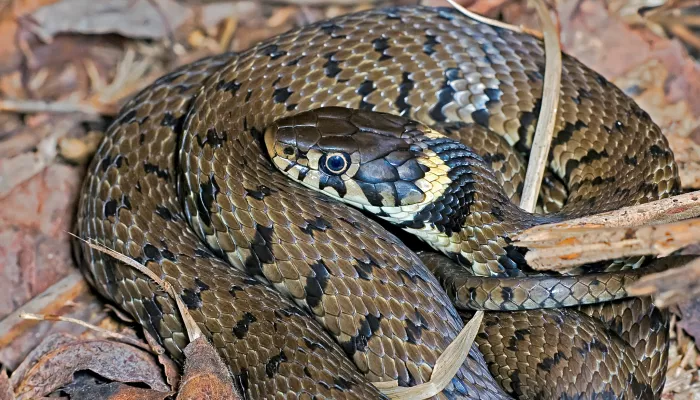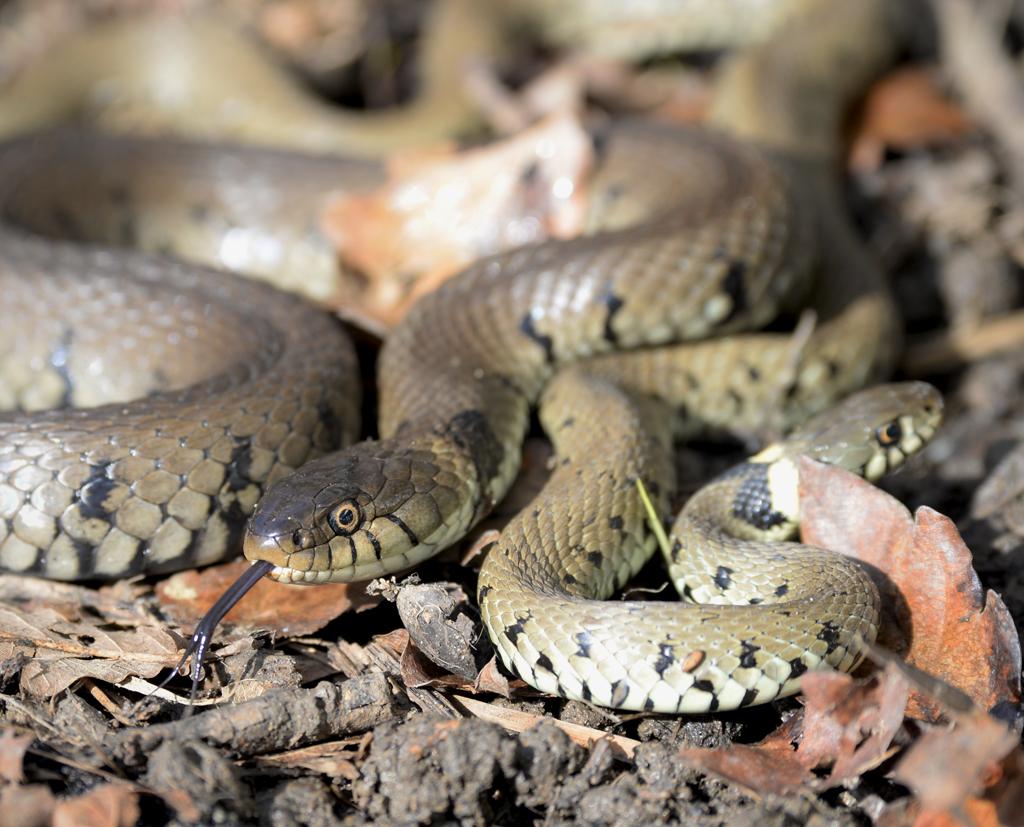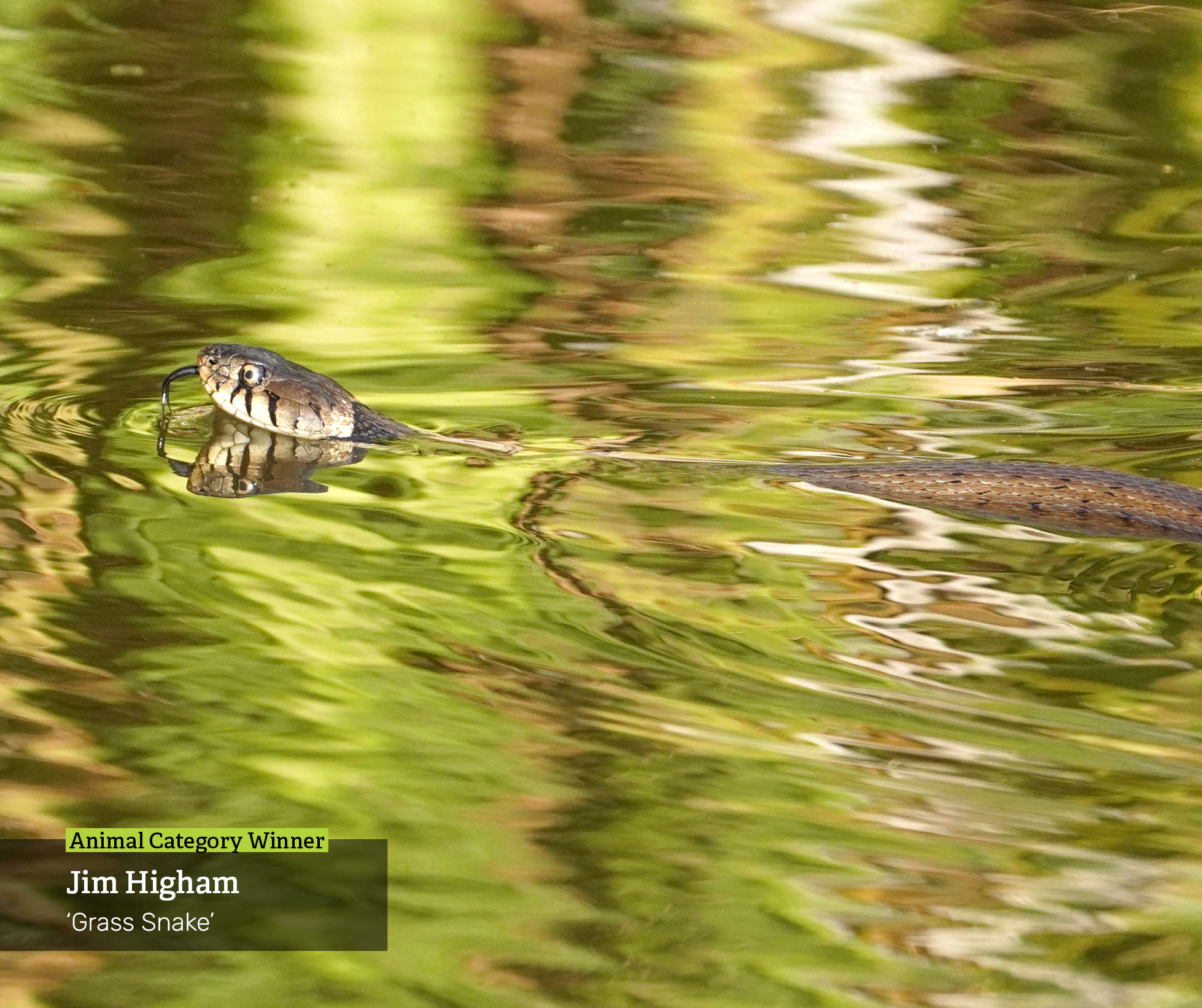Do grass snakes bite?
One of the biggest myths about British snakes is that they’re dangerous. On the contrary, our native grass snake isn’t venomous at all and will only very rarely bite. Grass snakes hunt using speed, stealth, and an element of surprise, aiming for prey like toads, frogs, newts, and even small fish or mice. They swallow their meals whole.
They can usually be found near freshwater, streams, ditches, ponds, or atop a sunny compost heap, at the edge of a woodland, or in a long grassy margin. They’re surprisingly good swimmers and you’ll occasionally see one gliding silently across a lake or river.
Harmless but clever
These timid creatures are non-aggressive and are harmless to humans. But if they’re in trouble, their tactics include hissing, puffing themselves up to appear bigger, or even playing dead. If worst comes to worst, their last resort is to release a pungent, garlic-smelling substance from their rear end to put off predators. That’ll do it!
When can you see grass snakes in the UK?
You’re most likely to spot a grass snake in the early morning or warm afternoons between March and October. Look out for them moving through water, basking on a compost heap, grassy bank, or log.
As temperatures rise from the end of March, grass snakes begin making their way out of hibernation – the males are typically first. April and May is mating season, so you might catch them basking in the sun prior to that as they ready themselves. By the time June and July roll around, the females will be laying their eggs.
They lay up to 40 leathery eggs, preferably in rotting vegetation (like compost heaps or manure piles) where the warmth helps them incubate safely.
The eggs hatch in late summer, and the young must immediately fend for themselves. Unfortunately, they face predation from all manner of animals – from badgers, herons, pheasants, and foxes to hedgehogs and domestic cats.
Grass snakes are creatures of habit, so if you see one once, you can try coming back to the same spot on another day. If you’re quiet and eagle-eyed, you might see it again! And if you aren’t lucky enough to see the snake itself, you might just spot one of its delicate ‘sheds’ – grass snakes shed their skin at least once during the summer months in a process called ecdysis.
Are grass snakes endangered?
Grass snakes are not endangered, but their numbers are thought to be declining. The primary reasons for this are habitat loss, changes in land use, and water pollution – which affect them so acutely because of their reliance on health wetland habitats and an abundance of amphibians.
They’re now listed as a priority species under the Biodiversity Action Plan and are protected by law in Great Britain.
The misunderstood symbol of Britain’s wilderness
The grass snake is a fantastic example of the wild creatures that live in and depend on our countryside and often go unnoticed or even feared. Now you know, the next time you hear a rustle in the undergrowth or catch sight of a slithering friend on your compost heap, you might have just seen one of Britain’s most wonderful beings – the barred grass snake.
How you can help grass snakes
So you want to be a friend to the humble grass snake? Here’s how you can help:
- Build a pond: Even a little pond can be enough to support frogs and newts – the grass snake’s prey.
- Don’t over-tidy: Leave piles of leaves, grass clippings, or a compost heap to create egg-laying or hibernation spots, and let some areas of your garden grow wild.
- Avoid pesticides: Pesticides and herbicides contain chemicals that can harm the prey grass snakes depend on.
- Inspire others: A community of grass snake-friendly gardens is more effective than one on its own.
Whatever the size of your outdoor space, there are things you can do to help. And, if you have access to a larger space like a schoolyard, churchyard, or workplace, encourage or get involved in creating designated wildlife piles or reptile refuges.
By supporting your local Wildlife Trust (like us!) you’ll be supporting vital conservation efforts that help protect and restore grass snake habitats.
Supporting grass snakes & the habitats they rely on
Right now, we're on a mission to raise £3 million to restore habitats and reverse species decline by 2030 through the KWT Nature Restoration Fund. It's a once-in-a-generation opportunity to fund nature’s recovery in Kent, focusing on the various habitats that make Kent special - like the wetlands and grasslands that grass snakes call home. Will you be part of a movement that will transform Kent’s wild future?



